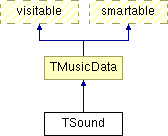
#include <TSound.h>
Inheritance diagram for TSound:

Public Types | |
| enum | { yes = -2, undefined = -1 } |
Public Member Functions | |
| virtual void | accept (TScoreVisitor &visitor) |
| void | setTempo (long tempo) |
| Tempo is expressed in quarter notes per minute. | |
| void | setDynamics (long dyn) |
| Dynamics (or MIDI velocity) are expressed as a percentage of the default forte value (90 for MIDI). | |
| void | setDacapo (YesNo::type yn) |
| Dacapo indicates to go back to the beginning of the movement. | |
| void | setSegno (long segno) |
| a segno mark. The value can be used to distinguish multiple jumps. | |
| void | setDalsegno (long ds) |
| dalsegno is used for backward jump to a segno sign. The value can be used to distinguish multiple jumps. | |
| void | setCoda (long coda) |
| a coda mark. The value can be used to distinguish multiple jumps. | |
| void | setTocoda (long tc) |
| tocoda is used for forward jump to a coda sign. The value can be used to distinguish multiple jumps. | |
| void | setDivisions (long div) |
| to be used with segno or coda attributes to avoid computation of divisions. | |
| void | setForwardRepeat (YesNo::type yn) |
| Forward-repeat is used when a forward repeat sign is implied, and usually follows a bar line. | |
| void | setFine (long fine) |
| The fine attribute follows the final note or rest in a movement with a da capo direction. It may take the special yes value. | |
| void | setPizzicato (YesNo::type pizz) |
| Pizzicato in a sound element effects all following notes. true indicates pizzicato, false indicates arco. | |
| void | setMidiChannel (long chan) |
| MIDI channel indication allow for detailed control of MIDI assignment. | |
| void | setMidiIntrument (long instr) |
| MIDI instrument indication allow for detailed control of MIDI assignment. | |
| long | add (const SMidiInstrument &instr) |
| long | getTempo () const |
| long | getDynamics () const |
| YesNo::type | getDacapo () const |
| long | getSegno () const |
| long | getDalsegno () const |
| long | getCoda () const |
| long | getTocoda () const |
| long | getDivisions () const |
| YesNo::type | getForwardRepeat () const |
| long | getFine () const |
| YesNo::type | getPizzicato () const |
| long | getMidiChannel () const |
| long | getMidiIntrument () const |
| vvector< SMidiInstrument > & | instrumentList () |
Protected Member Functions | |
| void | init () |
Friends | |
| EXP friend SMARTP< TSound > | newSound () |
 1.3.3
1.3.3